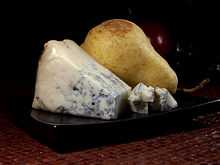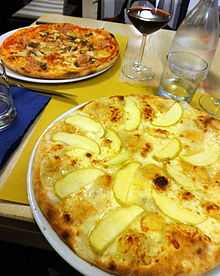Gorgonzola
| Gorgonzola | |
|---|---|
  | |
| Country of origin | Italy |
| Region, town | Gorgonzola |
| Source of milk | Cow |
| Pasteurized | Yes |
| Texture | Soft and crumbly |
| Fat content | 25-35% |
| Aging time | 3–4 months |
| Certification |
Italy: DOC from 1955; EU: PDO from 1996[1] |
Gorgonzola (/ɡɔrɡənˈzoʊlə/; Italian pronunciation: [ɡorɡonˈdzɔːla]) is a veined Italian blue cheese, made from unskimmed cow's milk. It can be buttery or firm, crumbly and quite salty, with a "bite" from its blue veining.
History
Gorgonzola has been produced for centuries in Gorgonzola, Milan, acquiring its greenish-blue marbling in the eleventh century. However, the town's claim of geographical origin is disputed by other localities.[2]
Production
Today, it is mainly produced in the northern Italian regions of Piedmont and Lombardy. Whole cow's milk is used, to which starter bacteria is added, along with spores of the mold Penicillium glaucum. Penicillium roqueforti, used in Roquefort cheese, may also be used. The whey is then removed during curdling, and the result aged at low temperatures.

During the aging process metal rods are quickly inserted and removed, creating air channels that allow the mold spores to grow into hyphae and cause the cheese's characteristic veining. Gorgonzola is typically aged for three to four months. The length of the aging process determines the consistency of the cheese, which gets firmer as it ripens. There are two varieties of Gorgonzola, which differ mainly in their age: Gorgonzola Dolce (also called Sweet Gorgonzola) and Gorgonzola Piccante (also called Gorgonzola Naturale, Gorgonzola Montagna, or Mountain Gorgonzola).
Under Italian law, Gorgonzola enjoys Protected Geographical Status. Termed DOP in Italy, this means that it can only be produced in the provinces of Novara, Bergamo, Brescia, Como, Cremona, Cuneo, Lecco, Lodi, Milan, Pavia, Varese, Verbano-Cusio-Ossola and Vercelli, as well as a number of comuni in the area of Casale Monferrato (province of Alessandria).
Consumption
Gorgonzola may be eaten in many ways. It may be melted into a risotto in the final stage of cooking, or served alongside polenta. Pasta with gorgonzola is a dish appreciated almost everywhere in Italy by gorgonzola lovers; usually gorgonzola goes on short pasta, such as penne, rigatoni, mezze maniche, or sedani, not with spaghetti or linguine. It is frequently offered as pizza topping. Combined with other soft cheeses it is an ingredient of pizza ai quattro formaggi (four-cheeses pizza).
See also
- Blue cheese
- Italian cheese
References
- ↑ "Gorgonzola". Archived from the original on 2004-11-15. Retrieved 2013-03-01. (Italian)
- ↑ The birthplace of Gorgonzola. Maybe. | csmonitor.com
External links
-
 Media related to Gorgonzola (cheese) at Wikimedia Commons
Media related to Gorgonzola (cheese) at Wikimedia Commons - Consortium for the Protection of Gorgonzola Cheese
| ||||||||||||||||||